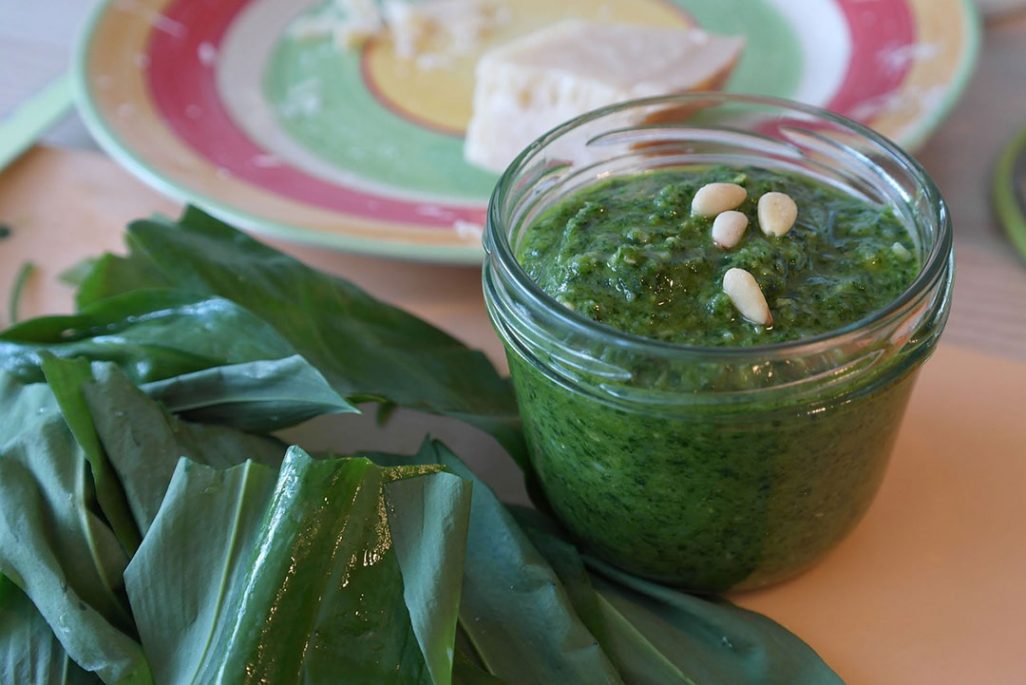
Foraging Ramsons
Foraging Wild Garlic (Allium ursinum)
The birds have been singing on the top of their lungs, announcing that finally and irrevocably spring is here at last. It came in with a blast of flowers that seemed to be popping up all at once, and now there is a veritable flood of petals both on the ground and in the trees. It is a lush and exuberant time – sheer bliss for any and all nature spirits. And it is incredibly hard to stay put, in front of a screen.
If you have been out there enjoying this blooming bliss, you might have noticed that in some parts of the woods there is a strong whiff of garlic lingering among the trees. You probably will have smelled it long before you discovered its likely source – a small but prolific plant, with broad leaves and a single flower stalk that rises from the centre and explodes into a white globe of star-like, little white flowers. You have discovered Ramsons (Allium ursinum), also known as ‘wild garlic’. This is one of my favourite spring edibles – prolific, tasty, versatile and very healthy.
All parts of this plant are edible, but I usually only gather the leaves, in order to safeguard the wild stands of this herbal treasure. I also don’t take the whole plant, but only some, preferably young leaves from each.
The medicinal value of wild garlic is similar to that of cultivated garlic. It is rich in vitamin C and iron and makes a great blood cleansing herb. Ramsons have a long history as a vitalising tonic spring herb. It can help alleviate arteriosclerosis and reduce high blood pressure. However, be aware that large quantities can have a drastic effect on the digestive system. Ramsons are no longer used medicinally, but if you let food be your medicines, as Hippocrates recommends, then make ample use of wild garlic as a great spring tonic.
CAUTION:
Be careful to wash the leaves very well. Growing so close to the ground and often near a stream, the ramsons can be contaminated the eggs of the fox tapeworm, which can be very harmful (even fatal) in humans. Fox tapeworm lodges in the liver or lungs, but can reside there undetected for years. Foragers can get regular check-ups for this infection. Although blood tests are not 100% accurate they may give some indication. If detected early the worm can be treated/operated upon successfully, but if left too late, it can destroy the liver. This safety warning applies to all herbs, berries and mushrooms that grow close to the ground, which exposes them more easily the faeces of an infected fox. The eggs are pretty durable in cool, damp conditions, but sensitive to heat and drying.
Note:
During the last decade, researchers have made some important new discoveries regarding drugs for the treatment of ‘alveolar echinococcosis’, the disease associated with fox tapeworm infestation. They found that some cancer drugs are quite promising as both diseases share some similarities. The treatment has become more efficient but it is not 100% perfect. Surgery remains the most effective option to date.
But I don’t want to spoil your appetite or foraging passion. Infection rates are very low, even among people who spend a lot of time in the woods and have a passion for gathering from the wild. Drying or heating destroys most organisms. Just make sure to blanch the Ramsons leaves briefly, or at least, be sure to wash them VERY WELL.

Recipes:
Ramsons Pesto
- 200g Ramsons Leaves
- 200g Basil Leaves
- 200g finely grated Parmesan cheese
- 150g Piñon nuts
- Olive oil, salt to taste
Take the fresh, young Ramsons leaves and wash thoroughly. Briefly scald the Ramson leaves with boiling water. Take the same amount of fresh Basil leaves and place both in a blender. Cover with Olive oil and blend until smooth. Add 200g finely grated parmesan cheese and blend until smooth. Add some piñon nuts (or crushed walnut pieces).
This pesto is very versatile – you can stir it into freshly cooked pasta, blend with crumbly goats- or feta cheese, or, mixed with Ricotta, use as a stuffing for homemade ravioli, or blend it with cream cheese to make a tasty bread spread. I am sure you will come up with gazillion more tasty ideas!
Ramsons have a very strong flavour, which is why it might be a good idea to blend it with another herb. Basil works great, as the two complement each other well. Other herbs you can use are chickweed, dandelion leaves or lambs quarters. Sun-dried tomatoes marinated in oil also make an excellent addition to this pesto recipe.
Ramsons also complement fish dishes very well. Fish chowder with a few Ramsons leaves or bulbs thrown in is a delight.
CAUTION:
Inexperienced foragers may confuse this plant with the poisonous Lily of the Valley, or Autumn Crocus leaves, which are also poisonous. However, Ramsons can be distinguished by the very distinctive, garlicky smell. If it doesn’t smell like garlic it is not ramsons. Once the flower head appears, there is no mistaking them. Learn how to identify them correctly before the flowers appear as that is the best time to collect them. The bulbs can be collected after flowering when the leaves have died down.

